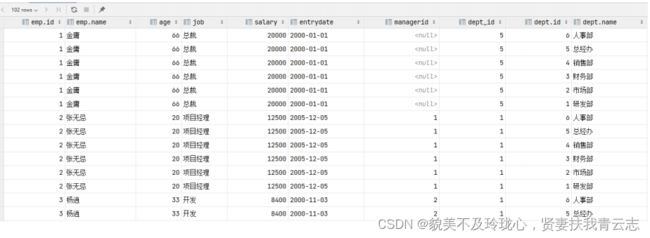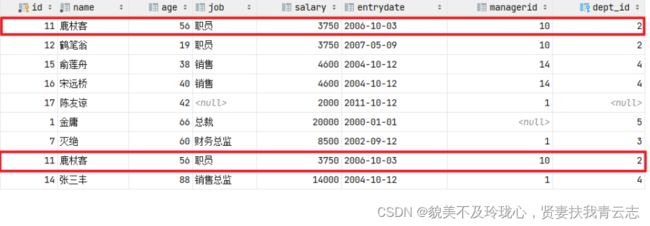MySQL数据库 多表查询
目录
多表关系
一对多
多对多
一对一
多表查询概述
内连接
外连接
自连接
自连接查询
联合查询
子查询
概述
标量子查询
列子查询
行子查询
表子查询
多表查询案例
多表关系
- 一对多(多对一)
- 多对多
- 一对一
一对多
多对多
create table student(
id int auto_increment primary key comment '主键ID',
name varchar(10) comment '姓名',
no varchar(10) comment '学号'
) comment '学生表';
insert into student values (null, '黛绮丝', '2000100101'),(null, '谢逊','2000100102'),(null, '殷天正', '2000100103'),(null, '韦一笑', '2000100104');
create table course(
id int auto_increment primary key comment '主键ID',
name varchar(10) comment '课程名称'
) comment '课程表';
insert into course values (null, 'Java'), (null, 'PHP'), (null , 'MySQL') ,(null,'Hadoop');
create table student_course(
id int auto_increment comment '主键' primary key,
studentid int not null comment '学生ID',
courseid int not null comment '课程ID',
constraint fk_courseid foreign key (courseid) references course (id),
constraint fk_studentid foreign key (studentid) references student (id)
)comment '学生课程中间表';
insert into student_course values (null,1,1),(null,1,2),(null,1,3),(null,2,2),(null,2,3),(null,3,4);一对一
SQL脚本:
create table tb_user(
id int auto_increment primary key comment '主键ID',
name varchar(10) comment '姓名',
age int comment '年龄',
gender char(1) comment '1: 男 , 2: 女',
phone char(11) comment '手机号'
) comment '用户基本信息表';
create table tb_user_edu(
id int auto_increment primary key comment '主键ID',
degree varchar(20) comment '学历',
major varchar(50) comment '专业',
primaryschool varchar(50) comment '小学',
middleschool varchar(50) comment '中学',
university varchar(50) comment '大学',
userid int unique comment '用户ID',
constraint fk_userid foreign key (userid) references tb_user(id)
) comment '用户教育信息表';
insert into tb_user(id, name, age, gender, phone) values
(null,'黄渤',45,'1','18800001111'),
(null,'冰冰',35,'2','18800002222'),
(null,'码云',55,'1','18800008888'),
(null,'李彦宏',50,'1','18800009999');
insert into tb_user_edu(id, degree, major, primaryschool, middleschool,university, userid) values
(null,'本科','舞蹈','静安区第一小学','静安区第一中学','北京舞蹈学院',1),
(null,'硕士','表演','朝阳区第一小学','朝阳区第一中学','北京电影学院',2),
(null,'本科','英语','杭州市第一小学','杭州市第一中学','杭州师范大学',3),
(null,'本科','应用数学','阳泉第一小学','阳泉区第一中学','清华大学',4);多表查询概述
-- 创建dept表,并插入数据
create table dept(
id int auto_increment comment 'ID' primary key,
name varchar(50) not null comment '部门名称'
)comment '部门表';
INSERT INTO dept (id, name) VALUES (1, '研发部'), (2, '市场部'),(3, '财务部'), (4,'销售部'), (5, '总经办'), (6, '人事部');
-- 创建emp表,并插入数据
create table emp(
id int auto_increment comment 'ID' primary key,
name varchar(50) not null comment '姓名',
age int comment '年龄',
job varchar(20) comment '职位',
salary int comment '薪资',
entrydate date comment '入职时间',
managerid int comment '直属领导ID',
dept_id int comment '部门ID'
)comment '员工表';
-- 添加外键
alter table emp add constraint fk_emp_dept_id foreign key (dept_id) references dept(id);
INSERT INTO emp (id, name, age, job,salary, entrydate, managerid, dept_id) VALUES
(1, '金庸', 66, '总裁',20000, '2000-01-01', null,5),
(2, '张无忌', 20, '项目经理',12500, '2005-12-05', 1,1),
(3, '杨逍', 33, '开发', 8400,'2000-11-03', 2,1),
(4, '韦一笑', 48, '开发',11000, '2002-02-05', 2,1),
(5, '常遇春', 43, '开发',10500, '2004-09-07', 3,1),
(6, '小昭', 19, '程序员鼓励师',6600, '2004-10-12', 2,1),
(7, '灭绝', 60, '财务总监',8500, '2002-09-12', 1,3),
(8, '周芷若', 19, '会计',48000, '2006-06-02', 7,3),
(9, '丁敏君', 23, '出纳',5250, '2009-05-13', 7,3),
(10, '赵敏', 20, '市场部总监',12500, '2004-10-12', 1,2),
(11, '鹿杖客', 56, '职员',3750, '2006-10-03', 10,2),
(12, '鹤笔翁', 19, '职员',3750, '2007-05-09', 10,2),
(13, '方东白', 19, '职员',5500, '2009-02-12', 10,2),
(14, '张三丰', 88, '销售总监',14000, '2004-10-12', 1,4),
(15, '俞莲舟', 38, '销售',4600, '2004-10-12', 14,4),
(16, '宋远桥', 40, '销售',4600, '2004-10-12', 14,4),
(17, '陈友谅', 42, null,2000, '2011-10-12', 1,null);- 连接查询:
- 内连接:相当于查询A、B交集部分数据
- 外连接:
- 左外连接:查询左表所有数据,以及两张表交集部分数据
- 右外连接:查询右表所有数据,以及两张表交集部分数据
- 自连接:当前表与自身的连接查询,自连接必须使用表别名
- 子查询
内连接
SELECT 字段列表 FROM 表1 , 表2 WHERE 条件 ... ;(2)显示内连接
SELECT 字段列表 FROM 表1 [ INNER ] JOIN 表2 ON 连接条件 ... ;案例一:查询每一个员工的姓名 , 及关联的部门的名称 (隐式内连接实现)
表结构: emp , dept
连接条件: emp.dept_id = dept.id
select emp.name , dept.name from emp , dept where emp.dept_id = dept.id ;
-- 为每一张表起别名,简化SQL编写
select e.name,d.name from emp e , dept d where e.dept_id = d.id;案例二:查询每一个员工的姓名 , 及关联的部门的名称 (显式内连接实现) --- INNER JOIN ... ON ...
表结构: emp , dept
select e.name, d.name from emp e inner join dept d on e.dept_id = d.id;
-- 为每一张表起别名,简化SQL编写
select e.name, d.name from emp e join dept d on e.dept_id = d.id;外连接
SELECT 字段列表 FROM 表1 LEFT [ OUTER ] JOIN 表2 ON 条件 ... ;SELECT 字段列表 FROM 表1 RIGHT [ OUTER ] JOIN 表2 ON 条件 ... ;select e.*, d.name from emp e left outer join dept d on e.dept_id = d.id;
select e.*, d.name from emp e left join dept d on e.dept_id = d.id;案例二:查询dept表的所有数据, 和对应的员工信息(右外连接)
select d.*, e.* from emp e right outer join dept d on e.dept_id = d.id;
select d.*, e.* from dept d left outer join emp e on e.dept_id = d.id;自连接
自连接查询
SELECT 字段列表 FROM 表A 别名A JOIN 表A 别名B ON 条件 ... ; 1select a.name , b.name from emp a , emp b where a.managerid = b.id;案例:查询所有员工 emp 及其领导的名字 emp , 如果员工没有领导, 也需要查询出来
select a.name '员工', b.name '领导' from emp a left join emp b on a.managerid = b.id;联合查询
SELECT 字段列表 FROM 表A ...
UNION [ ALL ]
SELECT 字段列表 FROM 表B ....;案例一:将薪资低于 5000 的员工 , 和 年龄大于 50 岁的员工全部查询出来.
当前对于这个需求,我们可以直接使用多条件查询,使用逻辑运算符 or 连接即可。 那这里呢,我们也可以通过union/union all来联合查询.
select * from emp where salary < 5000
union all
select * from emp where age > 50;子查询
概述
SELECT * FROM t1 WHERE column1 = ( SELECT column1 FROM t2 );- 标量子查询(子查询结果为单个值)
- 列子查询(子查询结果为一列)
- 行子查询(子查询结果为一行)
- 表子查询(子查询结果为多行多列)
- WHERE之后
- FROM之后
- SELECT之后
标量子查询
# 查询 "销售部" 部门ID
select id from dept where name = '销售部';
# 根据 "销售部" 部门ID, 查询员工信息
select * from emp where dept_id = (select id from dept where name = '销售部');案例:查询在 "方东白" 入职之后的员工信息
# 查询 方东白 的入职日期
select entrydate from emp where name = '方东白';
# 查询指定入职日期之后入职的员工信息
select * from emp where entrydate > (select entrydate from emp where name = '方东白');列子查询
案例:查询 "销售部" 和 "市场部" 的所有员工信息
# 查询 "销售部" 和 "市场部" 的部门ID
select id from dept where name = '销售部' or name = '市场部';
# 根据部门ID, 查询员工信息
select * from emp where dept_id in (select id from dept where name = '销售部' or name = '市场部');
案例:查询比 财务部 所有人工资都高的员工信息
# 查询所有 财务部 人员工资
select id from dept where name = '财务部';
select salary from emp where dept_id = (select id from dept where name = '财务部');
# 比 财务部 所有人工资都高的员工信息
select * from emp where salary > all ( select salary from emp where dept_id = (select id from dept where name = '财务部') );案例:查询比研发部其中任意一人工资高的员工信息
# 查询研发部所有人工资
select salary from emp where dept_id = (select id from dept where name = '研发部');
# 比研发部其中任意一人工资高的员工信息
select * from emp where salary > any ( select salary from emp where dept_id = (select id from dept where name = '研发部') );行子查询
# 查询 "张无忌" 的薪资及直属领导
select salary, managerid from emp where name = '张无忌';
# 查询与 "张无忌" 的薪资及直属领导相同的员工信息 ;
select * from emp where (salary,managerid) = (select salary, managerid from emp where name = '张无忌');表子查询
子查询返回的结果是多行多列,这种子查询称为表子查询。
# 查询 "鹿杖客" , "宋远桥" 的职位和薪资
select job, salary from emp where name = '鹿杖客' or name = '宋远桥';
# 查询与 "鹿杖客" , "宋远桥" 的职位和薪资相同的员工信息
select * from emp where (job,salary) in ( select job, salary from emp where name = '鹿杖客' or name = '宋远桥' );案例:查询入职日期是 "2006-01-01" 之后的员工信息 , 及其部门信息
# 入职日期是 "2006-01-01" 之后的员工信息
select * from emp where entrydate > '2006-01-01';
# 查询这部分员工, 对应的部门信息;
select e.*, d.* from (select * from emp where entrydate > '2006-01-01') e left join dept d on e.dept_id = d.id ;多表查询案例
create table salgrade(
grade int,
losal int,
hisal int
) comment '薪资等级表';
insert into salgrade values (1,0,3000);
insert into salgrade values (2,3001,5000);
insert into salgrade values (3,5001,8000);
insert into salgrade values (4,8001,10000);
insert into salgrade values (5,10001,15000);
insert into salgrade values (6,15001,20000);
insert into salgrade values (7,20001,25000);
insert into salgrade values (8,25001,30000);select e.name , e.age , e.job , d.name from emp e , dept d where e.dept_id = d.id;select e.name , e.age , e.job , d.name from emp e inner join dept d on e.dept_id = d.id where e.age < 30;(3) 查询拥有员工的部门ID、部门名称
表: emp , dept
select distinct d.id , d.name from emp e , dept d where e.dept_id = d.id;(4) 查询所有年龄大于40岁的员工, 及其归属的部门名称; 如果员工没有分配部门, 也需要展示出来(外连接)
表: emp , dept
select e.*, d.name from emp e left join dept d on e.dept_id = d.id where e.age >40 ;(5) 查询所有员工的工资等级
-- 方式一
select e.* , s.grade , s.losal, s.hisal from emp e , salgrade s where e.salary >= s.losal and e.salary <= s.hisal;
-- 方式二
select e.* , s.grade , s.losal, s.hisal from emp e , salgrade s where e.salary between s.losal and s.hisal;(6) 查询 "研发部" 所有员工的信息及 工资等级
select e.* , s.grade from emp e , dept d , salgrade s where e.dept_id = d.id and (e.salary between s.losal and s.hisal ) and d.name = '研发部';(7) 查询 "研发部" 员工的平均工资
select avg(e.salary) from emp e, dept d where e.dept_id = d.id and d.name = '研发部';# 查询 "灭绝" 的薪资
select salary from emp where name = '灭绝';
# 查询比她工资高的员工数据
select * from emp where salary > ( select salary from emp where name = '灭绝' );# 查询员工的平均薪资
select avg(salary) from emp;
# 查询比平均薪资高的员工信息
select * from emp where salary > ( select avg(salary) from emp ); 1# 查询指定部门平均薪资
select avg(e1.salary) from emp e1 where e1.dept_id = 1;
select avg(e1.salary) from emp e1 where e1.dept_id = 2;
# 查询低于本部门平均工资的员工信息
select * from emp e2 where e2.salary < ( select avg(e1.salary) from emp e1 where e1.dept_id = e2.dept_id );select d.id, d.name , ( select count(*) from emp e where e.dept_id = d.id ) '人数' from dept d;select s.name , s.no , c.name from student s , student_course sc , course c where s.id = sc.studentid and sc.courseid = c.id ;












